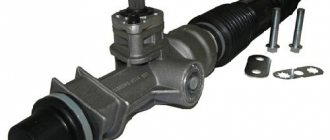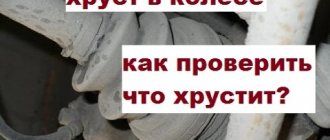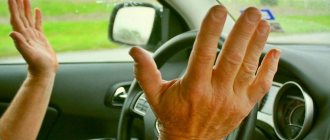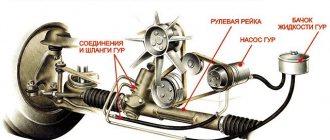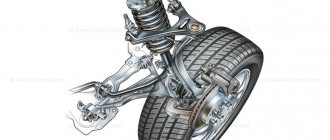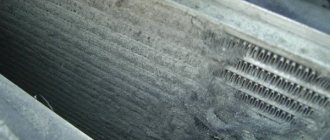Unusual reasons
Often sounds may not appear due to the failure of any element; non-standard reasons also occur. For example, one car enthusiast experienced a knocking noise after a pebble flew onto the subframe and got stuck there.
When the steering wheel was turned, the elements shifted, but they ran over this pebble, and when the steering wheel moved back, they jumped off it, making a knocking noise. Removing this stone eliminated the problem.
For the second car enthusiast, after repairing the suspension, the replaced front arm hit the subframe when turning, which was accompanied by a knocking sound. This problem was “cured” by raising the subframe with a pry bar.
These are somewhat unusual reasons for the appearance of knocking, but they have happened to car owners, so they should not be discounted.
In general, often the cause of extraneous sound when turning the steering wheel can be identified by carefully inspecting the front of the car, as well as checking the fastening of certain elements.
Steering wheel sticks when turning with ignition on
That is, it does not return back, but remains, as it were, bitten in the extreme left or right position. And this, even at a very low speed! Moreover, if the ignition is turned off, this situation is natural for any car. But when turned on... Agree, this can lead to irreparable consequences.
In this case, the problem of why the steering wheel sticks when turning is to blame for the faulty switch block, the steering column. You may have to deal with the ignition switch itself. Therefore, if you are not an automotive electrician, it is best not to take risks, since it is very difficult to carry out this work yourself without appropriate training. So, we turn on the emergency lights and slowly and carefully crawl to the nearest service station, where there is an appropriate specialist. And be careful when turning: enter them smoothly, without twisting the steering wheel to extreme positions, so as not to bite again.
Steering rack tightening
- In the very center of the steering rack, strictly on the opposite side, by touch we look for a rubber cap, which we remove from its place with our hands or with a screwdriver.
Any car enthusiast will enjoy this view from above. - Then, using a special key, we get to the rail and fix it in the seat.
- When performing work from the engine compartment, turn the key counterclockwise (when repairing under the car, clockwise - approx.).
It is on this seat (indicated by the yellow arrow) that the key should be fixed. - There is no need to tighten the rack; during the first tightening, the moment from the initial position should not exceed more than 30 degrees.
Step-by-step order of preparatory work
If you are not the lucky owner of a garage with a pit or a lift, work on tightening the steering rack can be done on the ground, but before doing this you need to prepare the work area.
- First of all, remove the battery, unscrew the terminals and fasteners of the batteries one by one (if available - approx.).
Remove the battery clamps carefully - We remove the battery and put it aside.
- Next, remove the mat under which there are 4 more bolts securing the battery stand.
By unscrewing these 4 bolts around the perimeter, the pillow can be easily removed - Then we move it forward a little so that it is detached from the air filter mounting pad.
- When nothing interferes with it, we move it in the opposite direction as much as is convenient for working with the steering rack.
Preparatory actions, dismantling unnecessary parts
To remove the crankcase protection, you need to unscrew 4 screws located in one row near the bumper. Also, unscrew two screws having a standard size of M6x16. In some configurations, the protection consists of two parts, but in this case they are attached only with self-tapping screws. These words are illustrated by the following photo:
First, unscrew the “10” screws, and then the two “18” screws. In the second case, there will be more screws (eight).
Now let's look at how to remove the battery. First of all, disconnect its terminals. Then, you need to move the additional fuse box to the side. In general, actions are performed according to the photo:
You also need to remove the mounting platform itself, for which you unscrew 4 screws. You will need a 13mm wrench, as well as a 10mm spanner. We will repeat the entire sequence again:
- Unscrew the nuts holding the battery terminals using a 10 mm wrench;
- Remove both terminals;
- Move the fuse box to the side by unscrewing 2 fastening screws;
- Unscrew the nuts with a 10mm wrench and remove the battery;
- Unscrew the screws with a 13mm wrench and remove the metal plate.
Just in case, here is a look at the fuse box mountings:
Mounting screws are located under the casing
Signs of a faulty steering mechanism
The first time after purchasing a car, novice drivers pay more attention to the road situation, without really listening to the behavior of the car.
The skill of keeping an eye on both the road and the car itself only comes with time.
This skill is very important because it allows a possible malfunction to be identified at an early stage, which can not only significantly reduce the cost of repairs, but also affect safety.
And it is not always possible to contact the service for diagnostics.
Any car consists of many components and mechanisms, and problems can arise with each of them. Moreover, a number of components of the car are responsible for safety during movement, so their condition must be monitored first.
New Lada: State program “First car” in 2022
These components include the steering mechanism.
Most malfunctions in cars are accompanied by the appearance of third-party sounds - noises, squeals, knocks.
And an experienced driver is able to determine, when they appear, which unit has problems.
But for example, not every experienced driver is able to identify the cause of a knock when pressing the brake or gas pedal.
The main sign of problems with the steering mechanism is also the appearance of third-party sounds.
Most often, the knocking occurs when the steering wheel is turned either in one or both directions.
Although it is worth noting that this is not always the case, the fault may also be with another component of the car, located next to the steering mechanism.
A knock in the steering mechanism is not a problem for certain car brands; it can appear in the Soviet-made VAZ-2106, in the new domestic Kalina, and in cars from European and Asian manufacturers.
Of course, the likelihood of such a problem occurring in a foreign brand car is somewhat lower than in Kalina, but it does exist.
The fault is often due to poor quality assembly of the car. The same VAZ “Kalina” is already structurally approaching foreign cars, but its assembly is still “lame”.
But Kalina and other cars from VAZ are still in demand, because their price is an order of magnitude lower than in Europe.
Therefore, a large segment of cars on our roads is occupied by domestically produced models.
Signs that your steering rack needs to be tightened
First, you need to turn down the radio volume and listen to the suspension work. If at low speeds there is a knocking sound over small irregularities, there may, of course, be several reasons, but the most likely is a loose steering rack. Secondly, you need to constantly monitor the steering play; its presence also indicates that the steering rack is not working in normal mode.
Moreover, the presence of play is an unpleasant signal; it makes the steering wheel’s reaction unpredictability in response to your actions, and even with a play of 10 degrees you will not pass the state inspection.
How to avoid
To avoid the appearance of new knocks after repair, you must follow a few simple rules:
- Do not reach high speeds on uneven and gravel-covered roads, as well as when driving over potholes and potholes. And if you still can’t avoid this, be sure to ensure that the steering wheel is not in the extreme position at the moment the front wheels come into contact with the obstacle.
- Do not make sudden acceleration or braking when the steering wheel is in the extreme position.
- Do not drive onto curbs or high curbs.
Thanks to following these simple rules, knocks will not bother you for a long time, and the steering rack will last even longer.
Causes related to drive and suspension
Now let's move on to other elements of the car in which knocking may occur when turning the steering wheel. There are not many of them, but malfunctions with them can lead to expensive repairs
If you hear a knocking sound with a crunching effect when the wheel is turned completely, this often indicates severe wear of the constant velocity joint (CV joint) used in the wheel drive mechanism.
The CV joint itself is a fairly reliable element if it is protected from dust and dirt getting inside. Read on the topic - replacing the inner CV joint boot of popular car models.
Therefore, it is quite easy to determine that this is the cause of the knocking when turning - you need to carefully inspect the protective boot.
If it is damaged, we can say with complete confidence that the cause of the third-party crunch is the CV joint.
Many car enthusiasts claim that it is possible to fully restore the performance of the CV joint by removing it, washing it and adding new lubricant.
Some additionally add small shavings of soft plastic to the lubricant, for example, from a cork from a Champagne bottle. Be sure to replace the damaged boot.
However, such measures can only delay the replacement of the hinge for a while and in the end it will still have to be replaced. And when to perform this operation - immediately upon detection of damage to the boot, or a little later - it is up to the car enthusiast to decide.
In many modern domestic cars, the weak point is the shock absorber strut bearing. It can also cause knocking.
This problem seems to be easily solved - it is enough to replace the support, but sometimes this is not very easy to do. After all, you will have to remove the entire rack from the car.
Also, a broken strut spring may be knocking in the suspension. At the same time, it will no longer be able to fully perform its functions, which will lead to rapid failure of the shock absorber.
Therefore, if noise appears, you should immediately inspect the spring. If it bursts, you will have to change it, and it is changed in pairs on both sides of the car.
New Lada: Real fuel consumption Lada Kalina 2 automatic transmission
If you hear a knocking sound on your car when turning, but it is also accompanied by a hum, it is likely that all this is due to wear on the wheel bearing.
It is quite easy to diagnose his condition.
You need to jack up the wheel on the side where the knock is coming from and rock it, checking for axial play.
If such play exists, the bearing needs to be replaced, which is impossible to do without the appropriate equipment and knowledge.
Preventing knocking noises
All of the above problems can arise not only with domestic cars, but also with expensive foreign cars. And the difference between these cars comes down only to the time after which the malfunction appears.
Naturally, a foreign car will pass more without a malfunction than the same Priora. But repairing a foreign car, if, for example, its CV joint has failed, will cost much more.
In most cases, knocking noises are caused by inadequate road surfaces. Moving over bumps and holes leads to the fact that all fasteners begin to weaken, hence the appearance of backlash.
To prevent knocking noises when turning the steering wheel, periodic inspection of all elements is required. Moreover, this will require very little, and you can do everything yourself.
The car is placed on an inspection hole or overpass, after which, while under it, you should carefully inspect all the elements, check the tightness of all fasteners with wrenches, tighten the nuts and bolts if necessary, swing the levers with a pry bar, checking for play.
If you do all this periodically, you can avoid the occurrence of knocking noises, or at least increase the life of the car before they occur.
Also, when traveling, you need to adhere to the speed limit, and go through difficult sections at low speed in order to slightly reduce the load on the elements of the suspension steering mechanism.
And if in front of you unexpectedly there are depressions in the road surface, then slow down the car (the car will seem to nose down), and immediately before the problem section of the road, release the brake pedal.
The front of the car will rise, thereby unloading the front suspension, and the car will coast over uneven roads without much damage to the chassis.
Diagnostics of the condition of components and troubleshooting
After carrying out a visual inspection of the suspension of the Lada Kalina, which will allow you to find out the cause of the knocking, you can proceed to dismantling the faulty elements. For example, car shock absorbers. Diagnostics are carried out by placing the car over an inspection hole or using a jack
Particular attention is paid to elements adjacent to the body or car frame
Diagnostics involves a thorough examination of the suspension elements, the presence of various damages, cracks and breaks on them. If a breakthrough is detected in the rubber protection of the steering tip, it must be repaired. Rubber seals are inspected for mechanical damage and those areas where there are breaks and cracks are identified.
As a result of a muffler breakage, a knock will be heard in the suspension. To identify the cause of such sounds, which may lie in the exhaust pipe, the muffler should be rocked in different directions. This is a quick way to diagnose the front suspension. After this is completed, you can proceed to suspension repair.
The front suspension consists of: 1 — nut for securing the upper strut support; 2 - bolt; 3 — upper support of the front suspension strut; 4 — bearing of the upper support of the strut; 5 — upper insulating gasket of the spring; 6 — front suspension spring; 7 — protective casing; 8 — telescopic stand assembly; 9, 10 — nuts securing the strut to the steering knuckle; 11 — bolt with eccentric; 12 - bolt; 13 — steering knuckle; 14 — front wheel drive shaft; 15 — stabilizer bar; 16 - stretching; 17 — lever; 18 — ball joint; 19 — hub; 20 — hub fastening nut; 21 — brake disc; 22 — front suspension compression buffer; 23 — upper spring cup; 24 — compression stroke limiter of the upper strut support; 25 — travel limiter of the upper strut support; 26 — stabilizer strut mounting nut; N - reference size
It is possible to eliminate various malfunctions that occur in the front suspension of the Lada Kalina car if their cause is known. If there are faulty front suspension struts that can knock, they should be replaced. In some cases, they can be repaired.
If during the diagnosis it was revealed that the bolts that secure the stabilizer bar that provides lateral stability to the car body are loose, then they need to be tightened. Worn rubber or rod pads are replaced.
If the fastening of the upper support of the Lada Kalina suspension strut is loose, then it is necessary to tighten the nuts securing this unit. If the front suspension exhibits destruction of the rubber support of the strut, then it must be replaced. If the rubber-metal hinges (silent blocks) are worn out, new ones should be installed.
The presence of a malfunction in the stabilizer bar struts requires replacement. If the front suspension spring settles and the front suspension spring breaks, it should be replaced. If the compression stroke buffer is destroyed, it is dismantled and a new one is installed. If there is increased wheel imbalance, you should contact a tire repair shop so that specialists can eliminate the identified malfunction.
Tightening process, video
There are several ways to tighten. One of them is the method of removing the slats. The removed rail is clamped in a vice and then, using a special wrench, the nut is tightened 10-15 degrees by turning it counterclockwise.
This is followed by a check for backlash and, if necessary, the procedure is repeated, since the backlash can be more or less. It is not advisable to overtighten, it will be difficult to rotate the steering wheel. The advantage of this method is the ease of adjustment, but the disadvantage is that you have to remove and then put the steering rack back in place, and this requires time, certain knowledge and skills.
The second method is simpler, it does not require removing the steering rack, you just need to remove the battery and the platform under it with four bolts, but it is much easier and faster than removing and installing the steering rack. This way we gain access to the steering rack and steering rods.
We take hold of the rod with our hand and begin to shake it with force. A characteristic knock will immediately indicate the presence of play. The stop nut is located on the rack behind the left link from the bottom; you need to feel it with your finger. Now the task is to get the wrench into the nut and then turn it counterclockwise. We check for play and, if necessary, tighten it further.
But in the video there is another tightening option, even without removing the battery:
Dismantling and disassembling the electric amplifier
Before removing the amplifier, you need to remove all the steering column switches. Remove the steering rack cover and dismantle the devices, remembering to disconnect the connectors from the power supply.
How to remove the EUR with your own hands:
- After removing the switches, you will need to dismantle the lower cross member of the dashboard. To do this, you need to press the fasteners that secure the connector with wires, and then disconnect the wiring from the control module. Once these steps are completed, you can disconnect the connector from the switches.
- The system bracket is secured with nuts; you will need to unscrew them with a wrench.
- After this, the steering rack will need to be carefully lowered down. To do this, you will need to find the bolt that secures the driveshaft to the booster shaft. This bolt must be unscrewed, but when unscrewing, you will need to fix the nut, this will prevent it from turning. When the bolt is removed, the fastening will need to be loosened, after which the intermediate shaft will be carefully removed. At this stage, we recommend marking the position of the shaft and gears; you can use a marker for this. This step is very important because doing it will prevent possible installation problems in the future. If the marks on the shafts do not match, this may cause problems with the amplifier. When dismantling, be careful not to damage the wiring, as this will also lead to the inoperability of the ESD.
- When the unit is dismantled, it will need to be disassembled and the failed elements replaced. Further editing is done in reverse order (the author of the video is Murzik Bely).
Common causes of knocking noise associated with the steering mechanism
Now let's look at typical problems and how to fix them.
The first thing you need to do is check the pressure in the wheels, because the difference in tire inflation may be the cause of the knocking.
Then check the fastening of the plastic protective fender liners. It is quite possible that the screws that secure them to the body have broken out, causing the fender liner to come off and cling to the wheel, making a knocking sound when turning.
In general, such a malfunction is very easy to fix; all you need to do is secure the torn fender liner with new screws.
The most dangerous from a safety point of view is the appearance of a knock in the steering mechanism itself. To check the condition of the mechanism, you will need to drive the car onto an overpass.
New Lada: DIY trunk for Lada Kalina. Lada Kalina station wagon trunk size
The first thing you need to check is the steering ends. Damage to the tip boot leads to sand getting inside it, which intensively wears out the surfaces of this element, causing play to appear in the tip, which is the source of knocking.
You can check the condition of the ends by loosening the tie rod with a pry bar.
Strong play and knocking will indicate wear on the tip and the need to replace it.
Steering ends for domestic cars are relatively inexpensive, and you can purchase them at almost any auto store.
Replacing them is also easy. It is recommended to replace both tips at once.
The complexity of performing this work comes down to the need to use a special puller.
After replacing the tips, you will still have to contact a service station to set the wheel alignment angles.
A knock may also appear in the steering rod silent blocks. They are located in the place where these rods are attached to the steering rack.
Delamination of the rubber of these silent blocks can also lead to knocking, although it will appear not only when turning, but constantly while driving.
This steering mechanism malfunction, although very rare, is still possible. It can be eliminated by removing the steering rods and pressing in new silent blocks.
A knock may also appear in the steering mechanism itself. It usually forms after the rack guide bushings wear out, causing a gap to appear between the rack and gear.
In some cases, everything can be eliminated by removing the gap with the mechanism's adjusting bolt.
If this is no longer possible, you will need to remove the mechanism from the car, disassemble it and replace the worn guide bushings.
A knock may even appear in the steering column universal joint.
If for some reason it is damaged, it is quite possible that it is the cause of the appearance of third-party sounds. This problem is “treated” by replacing the cardan.
You should also check the fastening of the mechanism body to the car body. Loose clamps may cause noise. This can all be eliminated by tightening the fastening nuts.
Malfunctions of RM Kalina and ways to eliminate them
Even the most reliable mechanisms wear out, especially if they are not protected from dust, dirt, water and aggressive environments. Although the steering rack of the Lada Kalina is located under the hood of the car and is protected from below by a pallet, during operation, especially in off-road conditions, it is exposed to all of the listed factors. The main malfunctions of the PM can be grouped into three groups:
- large free play of the steering wheel;
- knocking, noise and creaking in the mechanism;
- tight steering wheel.
Increased play, squeaks and knocking of the Kalina PM can be caused by:
- loosening the tie rod nuts,
- wear of their tips and silent blocks,
- loosening the PM fastening nuts,
- large gap between the rack and the adjusting nut.
These faults are easy to fix: you need to tighten the nuts and pin them where necessary, and replace the silent blocks with new ones.
Difficulty turning the Lada Kalina steering wheel can be caused by more serious reasons:
- wear of the bearings of the upper support of the steering column upper universal joint,
- damage to the rack support bushing,
- failure of the telescopic strut of the front suspension,
- faulty electric power steering or low tire pressure.
Many Lada Kalina owners are interested in whether it is possible to replace the standard rack with a mechanism of a different design. It's possible, but not necessary. The manufacturer does not structurally provide for the replacement of the rack and pinion steering mechanism with other types. Worm or screw PMs simply won't do. To facilitate steering wheel rotation, an electric power steering is installed on all Kalina models.
Repair, price
A lift is a fairly simple and quick way, but often it is only a partial, temporary solution to the problem. After all, the appearance of play can be caused by various reasons - the boot may be damaged, gaskets may leak and who knows what else, that is, there is a high probability that the steering rack is running dry.
If you suspect the need for repairs, consider whether you can handle it yourself. Get ready for the fact that you will have to spend the whole day in interesting positions, and you will also need an assistant to perform some operations. Do you know how to install the rack so that the steering wheel is level? If not, you risk having to do the installation again.
An alternative is a service station. They will charge you around 3,500 rubles for repairs, the repair kit costs 200 rubles and another 200 will be spent on anthers and so on.
The easiest option is to buy a new rack, complete with rods for about 6,000 rubles, there are, of course, racks with bells and whistles (short-stroke, sports, etc.), these cost about 10,000 rubles, the choice is yours.
Love and respect your steering rack and it will love you back!
Lyrical digression
In Lada Kalina, the steering rack never makes a knock when we are talking about a new car. Which is also true for . Let's say in your case this is not done. Then, do not try to repair anything, but go straight to the dealer. According to reviews, the defect in question is covered under warranty, and most car dealers do this: the steering rack assembly is replaced with a new one.
This is what the replacement unit looks like, the rack assembly
There is a logic here. At the factory, adjustments are made correctly (this is true in 99.9% of cases). If a defect appears, the dealer replaces the assembly without expecting that adjustment will solve the problem. The owner does not need to hope for this either. The choice is yours.
Steering rack - simplicity and reliability
The steering mechanism of a car is designed to change the direction of its movement. It has been tested and tested for more than a hundred years, but meticulous designers still find new solutions to improve its performance.
The steering rack is no exception - a relatively simple and reliable mechanism, the operating principle of which is based on the interaction of the “rack-and-pinion steering shaft worm” pair, which converts the rotational movement of the steering shaft into the reciprocating movement of the steering rods.

